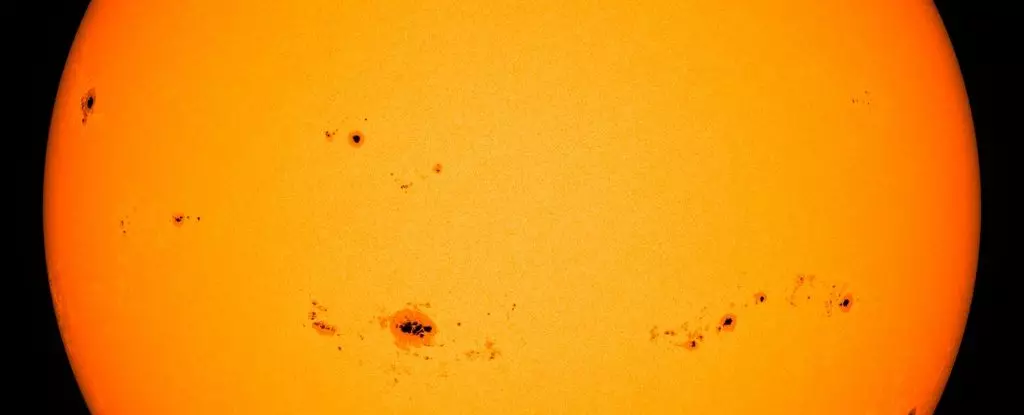As our planet spins in the vast expanse of space, the source of its light and life, the Sun, is entering a significant phase in its natural cycle. NASA, in collaboration with the National Oceanic and Atmospheric Administration (NOAA) and the Solar Cycle Prediction Panel, has confirmed that we are now experiencing solar maximum. This compelling period marks the climax of the Sun’s 11-year activity cycle, characterized by a noticeable increase in solar phenomena such as sunspots, solar flares, and coronal mass ejections (CMEs). With the Sun at its peak activity level, Earth is set to experience a series of exciting—but potentially disruptive—events in the coming months.
Solar maximum is not merely a moment of solar enthusiasm; it’s a vivid display of the dynamic nature of our closest star. As the Sun’s magnetic poles prepare to flip, the next few years will be a spectacle of energetic eruptions, increasing in intensity before the inevitable shift towards solar minimum, where activity wanes. Meteorologist Elsayed Talaat of NOAA emphasizes the uncertainty surrounding this cyclical journey, stating that while we have reached solar maximum, determining the exact peak activity period may take months or even years. This inherent unpredictability raises critical questions about our understanding of solar dynamics.
Despite our reliance on the Sun and the impact it has on life on Earth, much about the mechanics behind solar activity cycles remains shrouded in mystery. Each complete cycle lasts approximately 11 years, but there is significant variability in this timeframe, with intense flares and quiet periods that refuse to conform to expectation. Solar astrophysicist Michael Wheatland of the University of Sydney highlights the challenges we face in comprehending the solar dynamo— the very process that generates the magnetic fields giving rise to sunspots and solar flares. This gap in our understanding remains a central issue within the field of astrophysics, calling for ongoing research into the unpredictable nature of solar behavior.
Despite the challenges of forecasting solar cycles, scientists have honed in on sunspots as a reliable metric. These dark patches, resulting from concentrated magnetic energy, indicate locations where the Sun becomes increasingly turbulent, generating magnetic fields that eventually result in solar flares. During solar maximum, sunspots proliferate, transforming the Sun’s surface into a canvas marked by darkness against a glowing backdrop. The energy released during this period is no trivial matter; it has the capacity to produce powerful solar flares and CMEs, both of which can significantly impact Earth.
The presence of solar flares and CMEs carries with it a dual nature of potential dangers and breathtaking beauty. These solar events can cause radio blackouts and generate geomagnetic storms that disrupt communication systems, navigate technology, and create challenges for satellite operations. The effects can extend to power grids, generating currents that may jeopardize infrastructure. Yet, alongside these threats lies the awe-inspiring phenomenon of auroras, magical lights dancing across the night sky as solar particles collide with Earth’s atmospheric gases.
During the current solar cycle, which has surpassed initial expectations, researchers have noted a surge in auroral displays. While solar activity is indeed stronger than originally predicted, it’s vital to recognize that we are not currently facing catastrophic threats. For instance, the X9.0 flare that occurred on October 4th, within the top tier of historically measured flares, is formidable but not unprecedented. Our understanding of solar power does not end here; emerging research may shed new light on our predictive models and how we interpret solar patterns.
In light of the unexpected strength of the ongoing solar cycle, the scientific community is faced with important reflections. While some forecasts proved more accurate than official predictions, the discrepancies underscore the need for improved models and methodologies for anticipating solar activity. As we prepare for the months of intense solar activity ahead, it is paramount that scientists delve deeper into the complexities of our Sun’s behavior. Such inquiries could yield fresh insights, enhancing both our understanding of the Sun’s nature and the technologies we employ to monitor its impact on Earth.
As we embrace the forthcoming solar maximum, let us remain vigilant and enthusiastic about the wonders of our stellar neighbor. With each cycle’s ebbs and flows, the Sun continues to captivate our imaginations and challenge our understanding of cosmic phenomena. By fostering a spirit of inquiry and collaboration, we can navigate the turbulent yet awe-inspiring journey of solar activity and harness new knowledge from the magnificent and enigmatic force that fuels our planet.

Leave a Reply